19.62.070 Service areas and mechanical equipment.
A. Purpose.
1. To minimize adverse visual, odor, and noise impacts of mechanical equipment, utility cabinets and service areas at ground and roof levels.
2. To provide adequate, durable, well-maintained, and accessible service and equipment areas.
3. To protect residential uses and adjacent properties from impacts due to location and utilization of service areas.
B. Location of Ground-Related Service Areas and Mechanical Equipment.
1. Service areas (loading docks, trash dumpsters, compactors, recycling areas, electrical panels, and mechanical equipment areas) must be located for convenient service access while avoiding negative visual, auditory, olfactory, or physical impacts on the streetscape environment and adjacent residentially zoned properties. Service areas must be sited for alley access if available.
The Director may require evidence that such elements will not significantly impact neighboring properties or public areas. (For example, the Director may require noise-damping specifications for fans near residential zones.)
2. Exterior Loading Areas. Exterior loading areas for commercial uses must not be located within 20 feet of a residentially zoned property.
DEPARTURES may be allowed where such a restriction does not allow feasible development, and alternative design measures can successfully mitigate potential negative impacts. For example, areas and drives may be required by the reviewing authority to be separated from the residential lot by a masonry wall at least eight feet high.
3. Service areas must not be visible from the sidewalk and adjacent properties. Where the Director finds that the only option for locating a service area is an area visible from a street, internal pathway or pedestrian area, or from an adjacent property, the area must be screened with structural and or landscaping screening measures provided in subsection (C) below and AMC Chapter 19.65, Landscaping. Service elements accessible from an alley are exempt from screening requirements.
4. Design for Safety. Other provisions of this section notwithstanding, service areas used by residents must be located to avoid entrapment areas and other conditions where personal security is potentially a problem. The Director may require pedestrian-scaled lighting or other measures to enhance security.
5. Locate and/or shield noise-producing mechanical equipment, such as fans, heat pumps, etc., to minimize sounds and reduce impacts at property lines adjacent to residentially zoned properties.
6. Dumpster Storage Areas.
a. Dumpster storage areas must be provided for all nonresidential and multifamily development.
b. Dumpster storage areas must be on site and must not be located in the public right-of-way.
c. Dumpster storage areas must be sized to accommodate the minimum dumpster sizes (as provided by the Anacortes engineering design standards) for garbage, recycling, and composting.
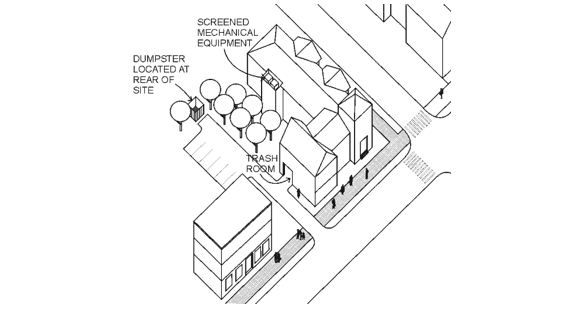
Locate service elements to reduce impacts on the residential and pedestrian environment, and provide appropriate enclosure. |
C. Screening of Ground-Related Service Areas and Mechanical Equipment.
1. Where screening of ground level service areas is required (see subsection (B)(3) of this section), the following applies:
a. A structural enclosure must be constructed of masonry, heavy-gauge metal, or decay-resistant material that is also used with the architecture of the main building. The reviewing authority may allow materials other than those used for the main building if the finishes are similar in color and texture or if the proposed enclosure materials are more durable than those for the main structure. The walls must be sufficient to provide full screening from the affected roadway, pedestrian areas or adjacent use. The enclosure may use overlapping walls to screen dumpsters and other materials (see Figure 19.62.070(C) below).
b. Gates must be made of heavy-gauge, site-obscuring material. Chain-link or chain-link with slats is not an acceptable material for enclosures or gates.
c. Where the interior of a service enclosure is visible from surrounding streets, pathways, and buildings, an opaque or semi-opaque horizontal cover or screen must be used to mitigate unsightly views. The horizontal screen/cover should be integrated into the enclosure design (in terms of materials and/or design).
d. Collection points must be located and configured so that the enclosure gate swing does not obstruct pedestrian or vehicular traffic, or does not require that a hauling truck project into any public right-of-way. Ensure that screening elements allow for efficient service delivery and removal operations.
e. The service area must be paved.
2. The sides and rear of service enclosures must be screened with landscaping at least five feet wide in locations visible from the street, parking lots, and pathways to soften views of the screening element and add visual interest.
DEPARTURES to the provisions of subsections (C)(1) and (2) of this section will be considered per AMC 19.20.220, provided the enclosure and landscaping treatment meet the purpose of the standards and add visual interest to site users.
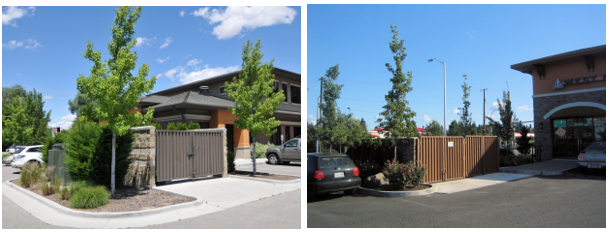
|
|
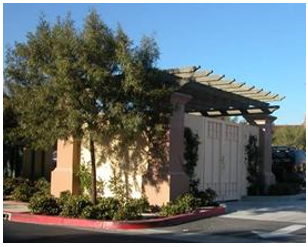
|
All three examples use durable and attractive enclosures with trees and shrubs to soften views of the enclosures from the side. The lower left example uses a trellis structure on top—a desirable example particularly where the top of the enclosures are visible from surrounding buildings, streets, and pathways (due to topography or building heights). |
D. Utility Meters, Electrical Conduit, and Other Service Utility Apparatus. These elements must be located and/or designed to minimize their visibility to the public. Project designers are strongly encouraged to coordinate with applicable service providers early in the design process to determine the best approach in meeting these standards. If such elements are mounted in a location visible from the street, pedestrian pathway, shared open space, or shared auto courtyards, they must be screened with vegetation and/or integrated into the building’s architecture.
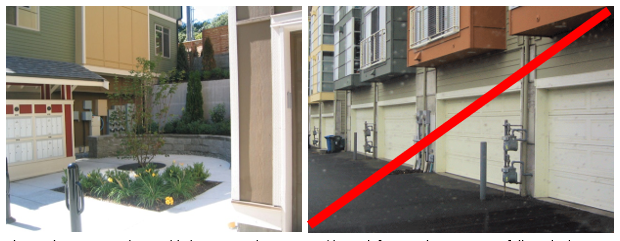
Place utility meters in less visible locations. The upper and lower left examples are successfully tucked away in a less visible location and/or screened by vegetation. The right images are poorly executed and would not be permitted in such visible locations. Such meters must be coordinated and better integrated with the architecture of the building. 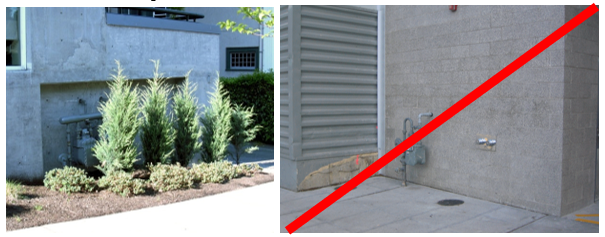
|
E. Location and Screening of Roof-Mounted Mechanical Equipment.
1. All rooftop mechanical equipment, including air conditioners, heaters, vents, and similar equipment, must be fully screened from public view at the street level. Screening must be located so as not to interfere with operation of the equipment.
Exception: Roof-mounted wind turbines, solar energy systems, and rainwater reuse systems do not require screening.
2. For rooftop equipment, all screening devices must be well integrated into the architectural design through such elements as parapet walls, false roofs, roof wells, clerestories, or equipment rooms. Screening walls or unit-mounted screening is allowed but less desirable. Wood must not be used for screens or enclosures. Louvered designs are acceptable if consistent with building design style. Perforated metal is not permitted.
3. The screening materials must be of material requiring minimal maintenance and must be as high as the equipment being screened.
4. Locate and/or shield noise-producing mechanical equipment such as fans, heat pumps, etc., to minimize sounds and reduce impacts to adjacent properties.
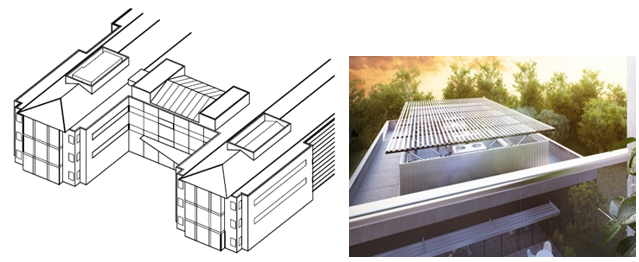
The left illustration shows how rooftop mechanical equipment can be located and screened effectively. The right image shows effective location and screening, including side walls and a trellis to screen views from taller surrounding buildings. |
(Ord. 3040 § 2 (Att. A), 2019)